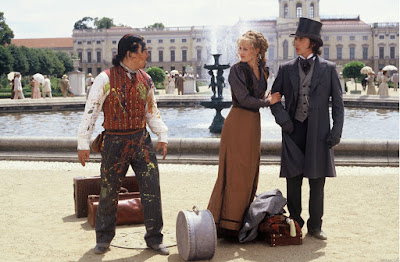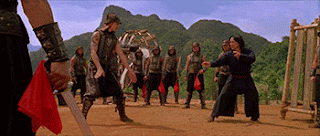"INFERNO" (2016) Review
Author Dan Brown has written at least four novels featuring the character of Harvard University professor Robert Langdon. At least three of them have been adapted for film by producer Brian Grazer and director Ron Howard. Although three years had passed between the first two movies, "THE DaVINCI CODE" (2006) and "ANGELS & DEMONS" (2009), Grazer and Howard waited another seven years before their third adaptation, "INFERNO", hit the movie screens.
Based upon Brown's 2013 novel, "INFERNO" begins with a mystery. Robert Langdon awakens inside a hospital room in Florence, Italy, with no memory of what happened to him during the past few days, but with occasional visions of a scorched Earth. One of the doctors tending him, Dr. Sienna Brooks, reveals that he is suffering from amnesia, due to a bullet wound to the head. When the pair discovers that another doctor is actually an assassin after Robert, Sienna helps him escape. The pair find a "Faraday pointer", a miniature image projector with a modified version of Sandro Botticelli's famous painting "Map of Hell", which is based on Dante's 14th century painting, "Dante's Inferno". Robert and Sienna realize this is the first clue in a trail left by Bertrand Zobrist, a billionaire geneticist who believed that rigorous measures were necessary to reduce the Earth's growing population. Zobrist had earlier committed suicide after being chased by armed government agents. As Robert and Sienna set about finding the virus created by Zobrist, they are chased by two parties. One of them is the hospital assassin, a woman named Vayentha, who works for a private security company called "The Consortium", who is acting on behalf of Zobrist. They are also being chased by agents of the World Health Organization (WHO).
"INFERNO" proved to be a box office flop . . . at least in the United States. International moviegoers, on the other hand, embraced the film, making it an international hit. How did I feel about the film? To be honest, I rather liked. Actually, I like all three film adaptations of Dan Brown's novel. But I would place "INFERNO" at number two. I would not regard it as fascinating as "THE DaVINCI CODE", but I certainly found it more interesting than "ANGELS & DEMONS" due to a twist to the narrative that I did not see coming.
Was there anything I found negative about the film? A part of me wished that Robert Langdon's talent for religious iconology and symbology had played a stronger role in the movie. No, I take that back. Langdon's talent in these field did play a strong role. Through him, he was able to find the virus created by Zobrist. He was also able to find the location where Zobrist and later his followers planned to release the virus. But like "ANGELS & DEMONS", the narrative for "INFERNO" did not provide that much insight in the world of religious and historic iconology as the one for "THE DaVINCI CODE". It seemed a bit of a let down for me. I also have one other problem with "INFERNO" - namely the film's showdown between Langdon, the W.H.O. agents and Zorbrist's followers. Visually, I found the sequence's location inside the Basilica Cistern in Istanbul more than satisfying and strong in atmosphere. But I had a problem in how the leader of Zobrist's followers died. It seemed vague. And when I discovered that particular character had died before Langdon's struggle with another Zobrist follower, I was taken by surprise. Unpleasantly so.
But despite its flaws, I still enjoyed "INFERNO". It had a good, solid cast led by Tom Hanks. It was nice to see him portray Robert Langdon again. More importantly, I enjoyed how he conveyed Langdon's reaction over the unusual situation that the character found himself in the movie's beginning. I must admit that I was not that impressed by the news of Felicity Jones being cast as his co-star in this film. I simply could not imagine a possible screen chemistry between the pair. And yet, they worked well together. It helped that Jones gave an excellent performance, especially in those scenes in which her character seemed a bit overwhelmed in the situations in which they found themselves.
The movie featured other first-rate performances. Hanks had another female co-star - Sidse Babett Knudsen, who gave a warm and skillful performance as Langdon's former lover, W.H.O. director Elizabeth Sinskey. Omar Sy was exceptionally complicated and superb as Christoph Bouchard, leader of the SRS team (Surveillance and Response Support) of the European Centre for Disease Prevention and Control team looking for Langdon. Ana Ularu struck me as particularly intense as the Consortium agent ordered to follow Langdon. Ben Foster's performance as the transhumanist scientist Bernard Zobrist only appeared in a few scenes in the movie. Yet, the actor did an excellent job in conveying his character's charismatic personality. My favorite performance was given by Irrfan Khan, who was spot-on as head of "The Consortium", the security firm hired by Zobrist to ensure that the latter's virus would be found. I found Khan's performance to be not only entertaining, but also complex and ambiguous.
However, the performances were not the only aspect of "INFERNO" that I enjoyed. I will admit that I felt a bit of disappointment with the movie's Italian setting . . . especially since the previous Langdon film, "ANGELS & DEMONS" was also set in that country. However . . . I must admit that I found Salvatore Totino's sharp and colorful. I thought the cinematographer did an excellent job in capturing the beauty and color of Italy, Hungary and Turkey. And I thought both Tom Elkins and Daniel P. Hanley did a first-rate job with the film's editing - especially in the various action sequences and Langdon's flashbacks.
Despite my complaint that the film's narrative failed to engage in deeper exploration of Langdon's knowledge of iconology and the vague details of the main protagonist's death, I really had no problems with the narrative for "INFERNO". I thought it was a pretty damn good story. I liked how author Dan Brown and screenwriter David Koepp utilized Langdon's specialty to create a nail-biting thriller in which humanity's fate was threatened. Zorbrist proved to be another one of Brown's protagonist, whose extremist views set the story in motion. For some reason, I found myself admiring how the narrative for "INFERNO" combined elements of art history, philosophy, politics, a travelogue, and a James Bond thriller. All I can say is . . . good job.
I realize that "INFERNO" had received mainly negative reviews from critics. And personally, I would never regard it as one of the best films of 2016. But considering the original manner in which the plot commenced and the way screenwriter David Koepp balanced various elements to create an interesting story. And thanks to Ron Howard's slick direction and a first-rate cast led by Tom Hanks, "INFERNO" also proved to be very entertaining.





































